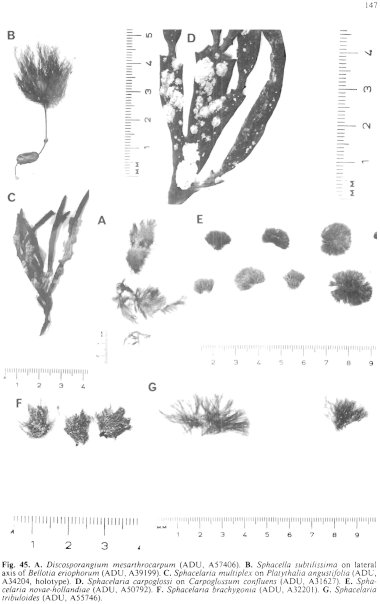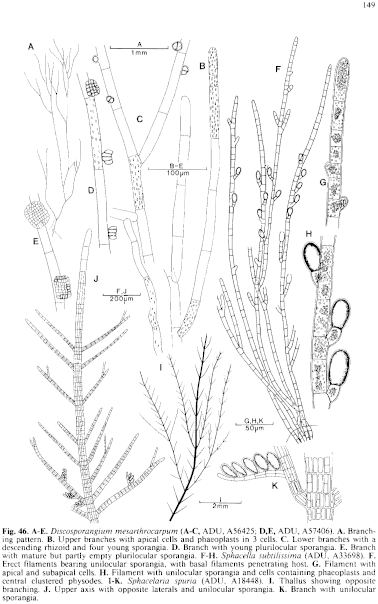|
|
|
|
|
|||||||||||
|
Electronic Flora of South Australia Species Fact Sheet
Phylum Phaeophyta – Order Sphacelariales – Family Sphacelariaceae
Selected citations: Sauvageau 1900: 229 (*R17), figs 3–5. Prud'homme van Reine 1982: 44, figs 27–38.
Thallus (Fig. 45B) dark brown, (1–) 2–3 mm long, with densely tufted or massed filaments extending 1–8 mm along and surrounding the host axes (Bellotia in southern Australia). Basal filaments penetrating the host tissue and branching within, erect filaments with few to several lateral branches arising radially at acute angles (Fig. 46F). Growth by a prominent apical cell (Fig. 46G) on each filament, with the subapical or next cell usually dividing transversely and thus producing pairs of cells of which the upper tends to be the shorter and may produce a lateral branch or a unilocular sporangium. Filaments (12–) 16–18 (–20) µm thick, of similar diameter throughout, mature cells L/B 2–4 (–6). Cells with discoid chloroplasts, sparse to moderately numerous, without pyrenoids, and with abundant physodes aggregated in one or two masses in each cell (Fig. 46G,H).
Reproduction: Reproduction by ovoid unilocular sporangia (Fig. 46H), 40–50 µm long and 25–30 µm in diameter, borne laterally on the erect filaments normally on a one-celled pedicel but sometimes terminal on a short branch.
Type from Minorca, Spain; in KIEL, PC.
Taxonomic notes: Distribution: Only known previously from the Western Mediterranean (see Prud'homme van Reine 1982, p. 44, fig. 43), on Carpomitra and Sporochnus from depths of 70 to 120 m.
In southern Australia, known from Pearson I., S., Aust., 16–23 m deep on Bellotia eriophorum (Shepherd, 9.i.1969; ADU, A33698) and Investigator Strait, S. Aust., 34 m deep, 35°27'S, 137°17'E ( Watson, 20.i.1971; ADU, A39199).
The South Australian collections agree so well with descriptions, dimensions and illustrations of Sphacella subtilissima that they can scarcely be separated from this species. The
Australian plants are slightly larger and occur on a different host (Bellotia) which is also a member of the Sporochnales. In both the Mediterranean and in South Australia, all collections are from deep water.
References:
PRUD'HOMME VAN REINE, W.F. (1982). A taxonomic revision of the European Sphacelariaceae (Sphacelariales, Phaeophyceae). Leiden Botanical Series, Vol. 6. (Brill: Leiden.)
REINKE, J. (1890) Uebersicht der bisher bekannten Sphacelariaceen. Ber. Deutsch. Bot. Ges. 8, 201–215.
REINKE, J. (1891). Beiträge zur vergleichenden Anatomie und Morphologie der Sphacelariaceen. Bibl. Bot. 23, 1–40, Plates 1–13.
SAUVAGEAU, C. (1900–1914). Remarques sur les Sphacélariacées. This was published as follows: pp. 1–51, J. de Bot. 14 (1900); pp. 51–167, Ibid. 15 (1901); pp. 167–228, Ibid. 16 (1902); pp. 228–332, Ibid. 17 (1903); pp. 332–348, Ibid. 18 (1904); pp. 348–480? (1904) and pp. 481–634 (1914), separately published with the above reprinted, 1914. (Bordeaux.)
The Marine Benthic Flora of Southern Australia Part II complete list of references.
Publication:
Womersley, H.B.S. (14 December, 1987)
The Marine Benthic Flora of Southern Australia
Part II
©Board of the Botanic Gardens and State Herbarium, Government of South Australia
Illustrations in Womersley Part II, 1997: FIGS 45B, 46 F–H.

Figure 45 enlarge
Fig. 45. A. Discosporangium mesarthrocarpum (ADU, A57406). B. Sphacella subtilissima on lateral axis of Bellotia eriophorum (ADU, A39199). C. Sphacelaria multiplex on Platythalia angustifolia (ADU, A34204, holotype). D. Sphacelaria carpoglossi on Carpoglossum confluens (ADU, A31627). E. Sphacelaria novae-hollandiae (ADU, A50792). F. Sphacelaria brachygonia (ADU, A32201). G. Sphacelaria tribuloides (ADU, A55746).

Figure 46 enlarge
Fig. 46. A–E. Discosporangium mesarthrocarpum (A–C, ADU, A56425; D,E, ADU, A57406). A. Branching pattern. B. Upper branches with apical cells and phaeoplasts in 3 cells. C. Lower branches with a descending rhizoid and four young sporangia. D. Branch with young plurilocular sporangia. E. Branch with mature but partly empty plurilocular sporangia. F–H. Sphacella subtilissima (ADU, A33698). F. Erect filaments bearing unilocular sporangia, with basal filaments penetrating host. G. Filament with apical and subapical cells. H. Filament with unilocular sporangia and cells containing phaeoplasts and central clustered physodes. I–K. Sphacelaria spuria (ADU, A18448). I. Thallus showing opposite branching. J. Upper axis with opposite laterals and unilocular sporangia. K. Branch with unilocular sporangia.

|
Email Contact: State Herbarium of South Australia |

|